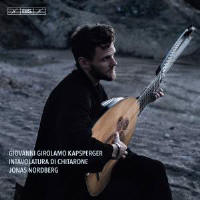Texte paru dans: / Appeared in:
BIS |
|
| " highly recommended " | |
|
Reviewer: James
V. Maiello Giovanni Girolamo Kapsberger (c. 1580–1651) was a prolific and highly inventive composer, but he often stands in the shadows of his contemporary Monteverdi, also working in Venice, and of Frescobaldi. As accomplished a lutenist as Frescobaldi was a keyboardist, Kapsberger did much to cement the status of the theorbo as a solo instrument in the 17th century. On this recording, Jonas Nordberg offers a glimpse into what it must have been like to hear the composer play his own music. Throughout, he plays Kapsberger’s virtuosic flourishes and chromatic twists with an informed sensitivity to the conventions and aesthetic norms of the early Baroque period and with a knowing nod to deviations from them.
The suite from the fourth book of intavolature that begins the program is a microcosm of the entire recording and it encapsulates Kapsberger’s later style. A sprawling, volatile toccata sets the stage, swinging between pyrotechnic passagework and almost meditative sections. Nordberg’s playing is exceptional, his flawless technique removing any limits on interpretation. He flies through the most demanding lines with characteristically Italian sprezzatura, but pivots almost instantly to render the more relaxed moments with deft gentility. One of the most impressive features of the passacaglia is that structural clarity never impedes the sense of musical spontaneity in the upper voices; the underlying chord progression and meter are comfortably present (unless obscured intentionally by the composer). A restrained galliard follows, and again Nordberg makes sure the central pillars of the genre are there, but he is not constrained by them in spinning a captivating musical web. The sectional nature of the canzona is an ideal vehicle for the contrasts so essential to the musical aesthetics of the period, and Nordberg makes the most of them, again using his formidable technique to create distinct musical identities.
Other
highlights on the recording include Kapsberger’s humorous take on the
battaglia, also from the fourth book of intabulations. From the ironic
grandiosity of the opening to the vivid imitations of trumpets and drums,
the piece seems tailored to Nordberg’s uncanny ability to create musical
effects on an instrument that is so often relegated to homogeneity.
Likewise, the autobiographical musical portrait Kapsberger is an inspired
reflection of the composer in both its music and in Nordberg’s thoughtful
reading, which just exudes humanity. Moreover, the engineers at BIS have
outdone themselves with sound that is warm and natural, resonant without
being artificially so. The microphone placement is just right for catching
some of the fingers moving over frets and the occasional, satisfying pluck
of a bass string, all without being distracting. Perhaps this is
unintentional, but it gives the music a slight edge that offsets some of
Nordberg’s most refined, sophisticated playing and the overall Gestalt
is almost magical. This is an outstanding recording in every way; highly
recommended. | |
|
|
|
|
|
|
|
Cliquez l'un ou l'autre
bouton pour découvrir bien d'autres critiques de CD |
|




